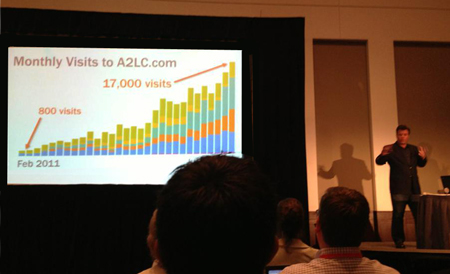by Ken Lopez
Founder/CEO
A2L Consulting
Public speaking does not come naturally to me, but I know I can deliver good results -- so long as I am prepared. Last week, I spoke at a conference session of about 300 people, and here was a piece of feedback I received from one lawyer in the audience, someone I had never met before.
"In more than two decades since I started studying and practicing law, I have seen 1000 experts speak in person on 1000 topics. Rarely do I feel compelled to write about a lecturer. Ken Lopez presented an incredible live program at the Inbound 2013 Conference, an event which attracted 5300 people from 35 nations. His advice stands out as unique and memorable - not only for attorneys - but for anyone in any business. Ken's phenomenal seminar proved that he is clearly the best at what he does."
Incredible, right? So how did I get such good results when public speaking does not come naturally to me? Here’s how.
My goal in telling you is to give you a sense of the level of preparation that we hope to see from most of our clients at A2L. After all, they have millions or even billions of dollars at stake in their presentations. I was merely giving a conference presentation where I was not likely to earn business or gain anything other than kind words.
First, some background on me. Even though most would describe me as outgoing, I am actually more introverted than extroverted. I simply chose, modeling my dad's behavior growing up, to adopt extrovert habits as I watched him win favors, airline upgrades and the best tables just by being outgoing and charming.
But, as long as I may have practiced acting extroverted, I still hate an event if I cannot connect meaningfully with one person. I actually prefer written communications to speaking, and I generally feel pretty awkward in a public speaking role. For the most part, my audience would not notice, but this is only the result of my hard work.
For the presentation I gave last week, I knew I’d be speaking to a group, half of whom knew more than me about the topic and half of whom knew less. Rather than try to research the topic extensively, I spoke simply about my experience. My topic, for what it's worth, was using publications like this blog to meaningfully connect with existing and future customers.
My scheduled talk was 40 minutes with 5 minutes of questions. Below are the 21 steps I went through to reach a great result.
Here is my exact preparation methodology. Where applicable, I make a comparison to trial preparation.
1. Getting Started (93 Days Prior to My Presentation): I became aware that I might have an opportunity to present at a high-profile marketing conference that I would attend anyway since I took on the Chief Marketing Officer role a couple of years ago.
2. Forced Early Preparation (90 Days Prior to My Presentation): I prepared a good but rough version of what I might present at a conference and presented it to a group of local CEOs. They were very happy with the content, and I indeed winged it for the most part with only a couple of practice sessions on my own. I got some valuable feedback from this group. This session was quite similar to the Micro-Mock session that we conduct at A2L, which I find helps trial attorneys gage how well their presentations are being received EARLY in the trial preparation process.
3. Theme Design (82 Days Prior to My Presentation): I worked with a person familiar with my actual audience to rough out my themes. In the trial presentation space, this discussion would be considered similar to my meeting with a jury consultant on a general topic.
4. Theme Decisions (62 Days Prior to My Presentation): I made the decision about what general topics would be included and those that would not be included.
5. Mind Mapping Session 1 (52 Days Prior to My Presentation): I use a technique called Mind Mapping that is useful for organizing most complex presentations -- whether an opening statement or a presentation like this.
6. Rough Outline (43 Days): I developed my first 12-point rough outline at this stage and shared it with my point of contact to solicit feedback.
7. Specific Outline (40 Days): Based on feedback from my point of contact, I refined my outline.
8. Mind Mapping Session 2 (37 Days): Whereas I had earlier only developed my mind map to the point where high level topics were fleshed out, I now took it to a deeper level and tried to consider the three points or so I'd like to make under each major topic.
9. Begin Graphics Work (33 Days): Although I had picked the designer I would be working with on my team a month before, we had our first serious walk-through of the subject matter about a month before I actually presented. He began work on a draft that was a combination of what I presented months before, what I developed in my mind map outline, and what he felt needed to be included.
10. Finalize First Presentation Draft (23 Days): I shared my first fully developed draft of the presentation with my point of contact at the conference.
11. Rehearsal 1 (21 Days): My first rehearsal via online meeting platform Go-To-Meeting occurred on this date with a couple of conference representatives.
12. Rehearsal 2 (20 Days): I believe that you are not really practicing unless you are practicing in front of an audience. I used a CEO peer group (my Vistage group) as my focus group for what works and what does not. I learned a lot.
13. Rehearsal 3 (19 Days): Another online presentation with my contact at the conference.
14. Graphics Refinement (18 Days): Although, there had been daily tweaking going on for two weeks, we did major refining of the graphics presentation at this point, mostly combining slides to cut out fat. As I always say, the slides you don't use are just as important as the ones that you do use.
15. Rehearsal 4 (14 Days): To help get new feedback, I invited 50 friends to one of 4 online practice sessions using Go-To-Meeting. This was the first. Each was attended by about 20 people.
16. Final Presentation (12 Days): I finalized my visual presentation.
17. Rehearsal 5 (8 Days): I presented to an online group of 20 and collected feedback. I also recorded this session to watch myself and adjust accordingly.
18. Rehearsal 6 (5 Days): I presented to an online group of 20 and collected feedback. I made some mistakes at the beginning, so I used one of my favorite memory techniques to memorize the first two minutes for my next sessions. What I do is assign each key thought to a room in a structure I know well, and then I mentally walk through it as I am speaking. I have fond memories of the house I grew up in, so I use that. For example, the sound of the doorbell reminded me to "invite" my audience in, the foyer reminded me to tell them exactly what I wanted from them, and so on. It's a very useful memory trick.
19. Rehearsal 7 (2 Days): I presented to an online group of 20 and collected feedback.
20. Day Before: I got plenty of sleep, I drank lots of water and I used my voice as little as possible.
21. Day Of: I continued to use my voice as little as possible and practiced my 2-minute intro in my head, walking through my childhood home.
All told, I devoted roughly 50 hours to the preparation of a 45 minute presentation. I think this ratio of roughly 1 hour of preparation for every 1 minute of presentation time is appropriate for any high-stakes presentation.
For trial, a preparation timeline along these lines is possible but probably a bit too compressed, unless it is a small case. For a medium sized case, I would double the days I indicated for each stage. If it is a large case, I would increase the prep time by a factor of 3x to 5x the number of days indicated.
Notice that I did not start prepping what I had to say in PowerPoint, and neither should you.
Here are some related articles covering topics such as practice, trial preparation and making great presentations:
- See our 1 year trial prep calendar
- The 14 most preventable trial preparation mistakes
- The 12 worst PowerPoint mistakes
- Free Download: Using Litigation Graphics to Persuade
- 10 steps we take after you suggest you might need some help with your next case
- 3 Ways to Force Yourself to Practice
- Free Download: Storytelling for Litigators
- The best way to draft a great opening statement
- How to structure an opening, speech or presentation








Leave a Comment